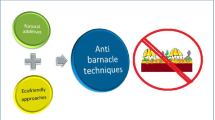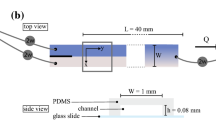Abstract
A very simple cationic monomer and a cationic hydrophobically associating polyacrylamide were synthesized, and the polymer was to function as a drag reducer. The structures of monomer and polymer were characterized by IR and NMR, and the drag-reducing rate, below and above the critical association concentration, (CAC) was tested. The modified polyacrylamide is a typical hydrophobically associating polymer, reaching a CAC at a mass concentration of about 0.25% (by weight). It is found from the friction test that the optimum concentration of the drag reducer is about 0.05% in fresh water, and the highest drag-reducing rate reaches as high as 72%. In addition, high concentration and high viscosity of drag reducer may impart negative impact on drag reduction rate in fresh water. While in brine, the optimum concentration is about 0.1%, and the highest drag-reducing rate is 68.4%. A high concentration has little negative impact on drag reduction rate, because viscosity is always very low. From the SEM images, it can be seen that the polymer can form network structure in fresh water. Above the CAC concentration, the network structure is significantly denser than that below the CAC concentration, but this is not conducive to the drag-reducing rate. In practical application, we always recommend using concentrations below CAC.
Graphical Abstract











Similar content being viewed by others
Data availability
All data generated or analyzed during this study are included in this published article.
References
Agheli L (2018) Oil depletion and quality of democracy in selected middle-east countries. Acta Oecon 68:101–114
Pickl MJ (2019) The renewable energy strategies of oil majors: from oil to energy? Energy Strategy Rev 26:100370
Shar AM, Mahesar AA, Memon KR (2018) Could shale gas meet energy deficit: its current status and future prospects. J Pet Explor Prod Technol 8:957–967
Bellani J, Verma HK, Khatri D, Makwana D, Shah M (2021) Shale gas: a step toward sustainable energy future. J Pet Explor Prod Technol 11:2127–2141
Solarin SA, Bello MO (2020) The impact of shale gas development on the US economy: evidence from a quantile autoregressive distributed lag model. Energy 205:118004
Shirazi M, Ghasemi A, Šimurina J (2022) The impact of the North American shale gas technology on the US energy security: the case of natural gas. Int J Sustain Energy 41:810–831
Gong B (2020) The development and implication of nature gas market in the context of the shale revolution//Gong B. Shale Energy Revolut 2020:19–36
Mei Y, Liu W, Wang J, Bentley Y (2022) Shale gas development and regional economic growth: evidence from Fuling, china. Energy 239:122254
Sun C, Nie H, Dang W, Chen Q, Zhang G, Li W, Lu Z (2021) Shale gas exploration and development in china: current status, geological challenges, and future directions. Energy Fuels 35:6359–6379
Wei J, Duan H, Yan Q (2021) Shale gas: will it become a new type of clean energy in china? a perspective of development potential. J Clean Prod 294:126257
Jinxing D, Yunyan NI, Quanyou L, Xiaoqi WU, Deyu G, Feng H, Zhang Y, Fengrong L, Zengmin Y, Hongwei LI (2021) Sichuan super gas basin in southwest china. Pet Explor Dev 48:1251–1259
Ma X, XIE J, (2018) The progress and prospects of shale gas exploration and development in southern Sichuan Basin, SW china. Pet Explor Dev 45:172–182
Ma X, Wang H, Zhou S, Shi Z, Zhang L (2021) Deep shale gas in china: geological characteristics and development strategies. Energy Rep 7:1903–1914
Yang B, Zhao J, Mao J, Tan H, Zhang Y, Song Z (2019) Review of friction reducers used in slickwater fracturing fluids for shale gas reservoirs. J Nat Gas Sci Eng 62:302–313
Xiong B, Roman-White S, Piechowicz B, Miller Z, Farina B, Tasker T, Burgos W, Zydney AL, Kumar M (2018) Polyacrylamide in hydraulic fracturing fluid causes severe membrane fouling during flowback water treatment. J Membr Sci 560:125–131
Huang F, Pu C, Lu L, Pei Z, Gu X, Lin S, Wu F, Liu J (2021) Gemini surfactant with unsaturated long tails for viscoelastic surfactant (VES) fracturing fluid used in tight reservoirs. ACS Omega 6:1593–1602
Ma X, Wang Z, Da QA, Cheng M, Yao C, Lei G (2017) Application of guar gum degrading bacteria in microbial remediation of guar-based fracturing fluid damage. Energy Fuels 31:7894–7903
Raei B, Peyghambarzadeh SM (2021) Experimental investigation of drag reduction in turbulent flow using biological and synthetic macromolecules: a comparative study. J Chem Petro Eng 55:117–137
Liu D, Wang Q, Wei J (2018) Experimental study on drag reduction performance of mixed polymer and surfactant solutions. Chem Eng Res Des 132:460–469
Malik S, Shintre SN, Mashelkar RA (1993) Enhancing the shear stability in drag-reducing polymers through molecular associations. Macromolecules 26:55–59
Liu Z, Zhou F, Qu H, Yang Z, Yushi Z, Wang D (2017) Impact of the microstructure of polymer drag reducer on slick-water fracturing. Geofluids 2017:1–8
Varnaseri M, Peyghambarzadeh SM (2020) Comprehensive study of the effect of the addition of four drag-reducing macromolecules on the pressure drop and heat transfer performance of water in a finned tube heat exchanger. J Macromol Sci Part B 59:747–773
Cole DP, Khosravi E, Musa OM (2016) Efficient water-soluble drag-reducing star polymers with improved mechanical stability. J Polym Sci Part A 54:335–344
Wei J, Jia W, Zuo L, Chen H, Feng Y (2022) Turbulent drag reduction with an ultra-high-molecular-weight water-soluble polymer in slick-water hydrofracking. Molecules 27:351
Mao J, Tan H, Yang B, Zhang W, Yang X, Zhang Y, Zhang H (2018) Novel hydrophobic associating polymer with good salt tolerance. Polymers 10:849
Jing X, Fu Z, Liu Y (2021) Effect of anionic surfactant on the properties of nonionic hydrophobically associating polymer based slick-water. J Dispers Sci Technol 44:342–348
Jing X, Huang C, Fu Z (2021) Synthesis and performance evaluation of a new drag reducer–cationic hybrid polymeric based on polyacrylamide. J Polym Res 28:1–10
Asidin MA, Suali E, Jusnukin T, Lahin FA (2019) Review on the applications and developments of drag-reducing polymer in turbulent pipe flow. Chinese J Chem Eng 27:1921–1932
Brostow W (2008) Drag reduction in flow: review of applications, mechanism and prediction. J Ind Eng Chem 14:409–416
Grothe DC, Meyer W, Janietz S (2012) Acrylate functionalized tetraalkylammonium salts with ionic liquid properties. Molecules 17:6593–6604
Pu W, Du D, Liu R, Gu J, Li K, Zhang Y, Liu P (2016) Synthesis and characterization of hyperbranched associative polyacrylamide. RSC Adv 6:39522–39529
Varnaseri M, Peyghambarzadeh SM (2020) The effect of polyacrylamide drag-reducing agent on friction factor and heat transfer coefficient in laminar, transition and turbulent flow regimes in circular pipes with different diameters. Int J Heat Mass Transfer 154:119815
Tamano S, Ikarashi H, Morinishi Y, Taga K (2015) Drag reduction and degradation of nonionic surfactant solutions with organic acid in turbulent pipe flow. J Non-Newtonian Fluid Mech 215:1–7
Fan F, Zhou F, Liu Z, Yang K (2019) Experimental study on drag reduction performance in fracture. 53rd US. Rock Mechanics/Geomechanics Symposium. New York
Nguyen TC, Romero B, Vinson E, Wiggins H (2018) Effect of salt on the performance of drag reducers in slickwater fracturing fluids. J Petrol Sci Eng 163:590–599
Jing X, Liu Y, Li W, Xu Y, Huang Z (2019) Using water-miscible nonionic hydrophobic monomer associating HPAM as drag-reducing agent. J Appl Polym Sci 136:48362
Zheng C, Huang Z (2018) Self-assembly and regulation of hydrophobic associating polyacrylamide with excellent solubility prepared by aqueous two-phase polymerization. Colloids Surf A 555:621–629
Sarsenbekuly B, Kang W, Fan H, Yang H, Dai C, Zhao B, Aidarova SB (2017) Study of salt tolerance and temperature resistance of a hydrophobically modified polyacrylamide based novel functional polymer for EOR. Colloids Surf A 514:91–97
Mao J, Xue J, Zhang H, Yang X, Lin C, Wang Q, Li C, Liao Z (2022) Investigation of a hydrophobically associating polymers temperature and salt resistance for fracturing fluid thickener. Colloid Polym Sci 300:569–582
Acknowledgements
This work was supported by Major Engineering Technology Field Test Project of CNPC (NO. 2019F-31) and Scientific Research and Technological Development Project of PetroChina (NO. 2022CGCGZ005).
Author information
Authors and Affiliations
Contributions
YX Idea, Investigation, Conceptualization, Writing-original draft, Writing-review & editing. XJ: Idea, Investigation, Conceptualization, Writing-original draft, Writing-review & editing. YT Idea, Project administration, Supervision. PZ: Investigation, Model establishment, Conceptualization.
Corresponding author
Ethics declarations
Conflicts of interest
The authors declare that there is no conflict of interest.
Rights and permissions
Springer Nature or its licensor (e.g. a society or other partner) holds exclusive rights to this article under a publishing agreement with the author(s) or other rightsholder(s); author self-archiving of the accepted manuscript version of this article is solely governed by the terms of such publishing agreement and applicable law.
About this article
Cite this article
Yuan, X., Xianwu, J., Yongfan, T. et al. Simple cationic polyacrylamide: a drag reducer. Iran Polym J 32, 1065–1074 (2023). https://doi.org/10.1007/s13726-023-01186-5
Received:
Accepted:
Published:
Issue Date:
DOI: https://doi.org/10.1007/s13726-023-01186-5




